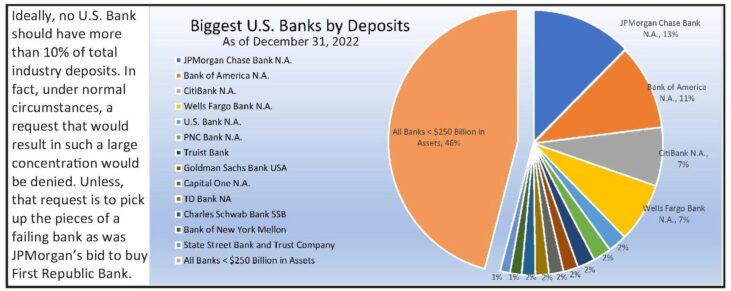The rule is that no single bank should have more than 10% of total industry deposits unless it grows organically. The exception to this 10% cap is when a failure is involved. So it was that history repeated itself, and the biggest keeps getting bigger.
On May 1st, regulators turned (once again) to 5-Star JPMorgan Chase Bank, N.A. to resolve the besieged First Republic Bank, San Francisco, CA, just as they did in 2008 when Washington Mutual Bank (WaMu) failed. In a way it seems fitting. It took the nation’s largest bank to step in when it came to handling the largest two bank failures in U.S. history. But is it really?
JPMorgan’s takeover of WaMu did not result in any cost to the deposit insurance fund. The same cannot be said of First Republic. In both cases, JPMorgan Chase assumed essentially all of the failing banks’ assets and deposits. In this latest transaction, however, it entered into a loss-sharing agreement with the FDIC. The estimated cost to the deposit insurance fund for First Republic’s resolution is $13 billion.
Perhaps more concerning is that in less than six months, 2023 has witnessed three of the largest four bank failures on record. Silicon Valley Bank (SVB), which catered to the tech industry and Signature Bank, which had hitched its wagon to crypto currencies, and now First Republic Bank, which fell in large part, due to a streak of bad press.
We have listed the 50 largest U.S. banks on page 5 of this week’s Jumbo Rate News. The first four, the behemoths, each have assets exceeding $1 trillion; nine others have assets that exceed $250 billion but less than $1 trillion. (These largest 13 are depicted in the chart on page 2); the other 37 banks listed on page 5 reported total assets at year-end 2022 between $50 billion and $250 billion. We have included the 2022 growth rates for both assets and deposits of each bank listed. (Although, the three with “FDIC” in Star-Rating column are sadly no longer with us.)
Acquirers of the first two 2023 failed banks, (actually the first failures since 2020), were smaller than the banks they acquired. The acquirer of record for Silicon Valley Bank (SVB) (which failed 3/10/23) was the $109 billion asset 5-Star First-Citizens B&TC, NC; while that of Signature Bank (failed 3/12/23) was 5-Star Flagstar Bank, NY, which reported year-end assets of $90 billion.
They weren’t complete acquisitions, though. After losing much of its value in SVB’s last days, First-Citizens purchased $72 billion of its remaining $167 billion in assets (at a discount). The purchase included all loans as well as the assumption of all deposits. The FDIC held on to $90 billion in securities and other assets “for later disposition”.
As for Signature Bank, Flagstar Bank, formerly known as New York Community Bank, took just $38 billion of Signature’s $110 billion in assets while the FDIC held on to $60 billion in loans. Flagstar did not bid for the $4 billion in deposits related to digital assets. Smart move.
Both of those transactions were completed by way of interim bridge banks, which are designed to maintain the bank’s value while regulators seek bids. Regulators were able to get at least four bids in for First Republic without going through a bridge bank set-up.
One of those bids was from 5-Star JPMorgan Chase Bank, our nation’s largest bank, by far. Even with a slight decline in 2022, JPM Chase controlled 13% of total industry deposits at the end of last year, far more than its closest competitor. The addition of all of First Republic’s will only serve to widen this divide.
The mandate says that the winning bid must be the least costly to the insurance fund. JPMorgan had that. Allowing the nation’s largest bank to grow in this manner comes with other risks. We would have been interested in seeing regulators entertain other bids, even if slightly more costly to the insurance fund. There were reportedly at least three other bidders, but once again, the nation’s largest bank gets even larger.
As of year-end 2022 data, 13 Banks control over half of all U.S. bank assets.


